Footnotes
- ↑ Mudrooroo (1994). Aboriginal mythology: An A-Z spanning the history of the Australian Aboriginal people from the earliest legends to the present day. London: Thorsons. p. 37. ISBN 978-1-85538-306-7.
In Tiwi mythology, Papinijuwaris are one-eyed giants who live in a large hut where the sky ends. Shooting stars are said to be Papinijuwaris stalking across the heavens with a burning firestick in one hand and a fighting club in the other. Papinijuwaris feed on the bodies of the dead and the blood of the sick. They are able to locate sick people by smell, and upon finding a victim will make themselves invisible and suck the person's blood without leaving a wound. As the sick person weakens, the Papinijuwari makes itself small enough to enter the body through the mouth and drinks up the rest of the blood from the inside. [1]

Planetary nomenclature, like terrestrial nomenclature, is a system of uniquely identifying features on the surface of a planet or natural satellite so that the features can be easily located, described, and discussed. Since the invention of the telescope, astronomers have given names to the surface features they have discerned, especially on the Moon and Mars. To found an authority on planetary nomenclature, the International Astronomical Union (IAU) was organized in 1919 to designate and standardize names for features on Solar System bodies.
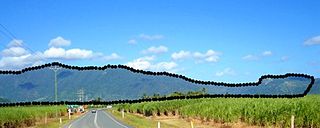
Australian Aboriginal religion and mythology is the sacred spirituality represented in the stories performed by Aboriginal Australians within each of the language groups across Australia in their ceremonies. Aboriginal spirituality includes the Dreamtime, songlines, and Aboriginal oral literature.

The Aboriginal Tasmanians are the Aboriginal people of the Australian island of Tasmania, located south of the mainland. For much of the 20th century, the Tasmanian Aboriginal people were widely, and erroneously, thought of as being an extinct cultural and ethnic group that had been intentionally exterminated by white settlers. Contemporary figures (2016) for the number of people of Tasmanian Aboriginal descent vary according to the criteria used to determine this identity, ranging from 6,000 to over 23,000.

Strzyga is usually a female demon in Slavic mythology, which stems from the mythological Strix of Ancient Rome and Ancient Greece. The demon is somewhat similar to a vampire, and is predominantly found in Polish and Silesian folklore.

Taipans are snakes of the genus Oxyuranus in the elapid family. They are large, fast-moving, highly venomous, and endemic to Australia and New Guinea. Three species are recognised, one of which, the coastal taipan, has two subspecies. Taipans are some of the deadliest known snakes.

The Rainbow Serpent or Rainbow Snake is a common deity often seen as a creator god, known by numerous names in different Australian Aboriginal languages by the many different Aboriginal peoples. It is a common motif in the art and religion of many Aboriginal Australian peoples.
Estonian mythology is a complex of myths belonging to the Estonian folk heritage and literary mythology. Information about the pre-Christian and medieval Estonian mythology is scattered in historical chronicles, travellers' accounts and in ecclesiastical registers. Systematic recordings of Estonian folklore started in the 19th century. Estonian mythology seems to be heavily influenced and borrowed from Vedic religion. Pre-Christian Estonian deities included a god known as Jumal or Taevataat in Estonian, corresponding to Jumala in Finnish, and Jumo in Mari. Numerous folktales of the religion are similar to those in Indo Aryan and Buddhist mythologies, which shows a wide influence but not formal conversion to them.

The Australian Red Cross, formally the Australian Red Cross Society, is a humanitarian aid and community services charity in Australia. Tracing its history back to 1923 and being incorporated by royal charter in 1941, the Australian Red Cross Society is the national member of the Federation of Red Cross and Red Crescent Societies and part of the International Red Cross Movement. The Australian Red Cross is guided by the Fundamental Principles of the International Red Cross and Red Crescent Movement and as such is a non-religious, neutral, impartial and independent humanitarian organisation.
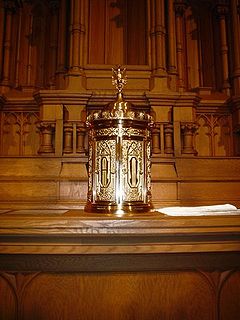
In Christian traditions which practice the Eucharist or Holy Communion, a tabernacle or sacrament house is a fixed, locked box in which the Eucharist is stored as part of the "reserved sacrament" rite. A container for the same purpose, which is set directly into a wall, is called an aumbry.
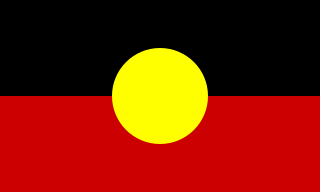
Aboriginal Australians are the various Indigenous peoples of the Australian mainland and many of its islands, such as Tasmania, Fraser Island, Hinchinbrook Island, the Tiwi Islands, and Groote Eylandt, but excluding the Torres Strait Islands. The term Indigenous Australians refers to Aboriginal Australians and Torres Strait Islanders collectively. It is generally used when both groups are included in the topic being addressed. Torres Strait Islanders are ethnically and culturally distinct, despite extensive cultural exchange with some of the Aboriginal groups. The Torres Strait Islands are mostly part of Queensland but have a separate governmental status.
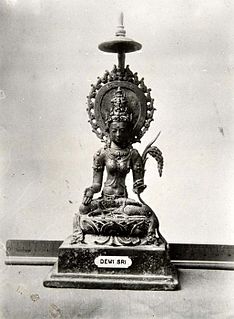
There are many Malay ghost myths, remnants of old animist beliefs that have been shaped by Hindu-Buddhist cosmology and later Muslim influences, in the modern states of Brunei, Indonesia, Malaysia, Singapore and among the Malay diaspora in neighbouring Southeast Asian countries. The general word for ghost is hantu, of which there exist a wide variety. Some ghost concepts such as the female vampires pontianak and penanggal are shared throughout the region. While traditional belief doesn't consider all ghosts as necessarily evil, Malaysian popular culture tends to categorise them all as types of evil djinn.

A kurdaitcha, or kurdaitcha man, also spelt gadaidja, cadiche, kadaitcha, karadji, or kaditcha, is a type of shaman amongst the Arrernte people, an Aboriginal group in Central Australia. The name featherfoot is used to denote the same figure by other Aboriginal peoples.
Adnoartina is known as a religious deity in the Australian Aboriginal culture. This deity is described as taking the form of a gecko lizard and is considered to be a sacred ancestral being. Adnoartina offers an Indigenous understanding to the creation of Uluru, an Australian historical landmark. This landmark is regarded as one of the most sacred land formations in Australia and an ‘iconic’ tourist attraction. As Adnoartina is a key figure in the creation of Uluru, this deity is a symbolic figure in the Aboriginal religion.
Australian Aboriginal culture includes a number of practices and ceremonies centered on a belief in the Dreamtime and other mythology. Reverence and respect for the land and oral traditions are emphasised. Over 300 Languages and other groupings have developed a wide range of individual cultures. Due the colonization of Australia under terra nullius concept these cultures were treated as one monoculture. Australian Aboriginal art has existed for thousands of years and ranges from ancient rock art to modern watercolour landscapes. Aboriginal music has developed a number of unique instruments. Contemporary Australian Aboriginal music spans many genres. Aboriginal peoples did not develop a system of writing before colonisation, but there was a huge variety of languages, including sign languages.

A pocong, also known as shroud ghost, is an Indonesian and Malaysian ghost that is said to be the soul of a dead person trapped in their shroud. Known in Indonesia as kain kafan, the shroud is the prescribed length of cloth used in Muslim burials to wrap the body of the dead person. The dead body is covered in white fabric tied over the head, under the feet, and on the neck.
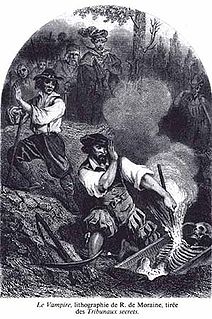
Legends of vampires have existed for millennia; cultures such as the Mesopotamians, Hebrews, ancient Greeks, and Romans had tales of demonic entities and blood-drinking spirits which are considered precursors to modern vampires. Despite the occurrence of vampire-like creatures in these ancient civilizations, the folklore for the entity known today as the vampire originates almost exclusively from early 18th-century Southeastern Europe, particularly Transylvania as verbal traditions of many ethnic groups of the region were recorded and published. In most cases, vampires are revenants of evil beings, suicide victims, or witches, but can also be created by a malevolent spirit possessing a corpse or a living person being bitten by a vampire themselves. Belief in such legends became so rife that in some areas it caused mass hysteria and even public executions of people believed to be vampires.
There are a vast array of myths surrounding the Blackfoot Native Americans as well as Aboriginal people. The Blackfeet inhabit the Great Plains, in the areas known as Alberta, Saskatchewan, and areas of Montana. These stories, myths, origins, and legends play a big role in their everyday life, such as their religion, their history, and their beliefs. Only the elders of the Blackfoot tribes are allowed to tell the tales, and are typically difficult to obtain because the elders of the tribes are often reluctant to tell them to strangers who are not of the tribe. People such as George B. Grinnell, John Maclean, D.C. Duvall, Clark Wissler, and James Willard Schultz were able to obtain and record a number of the stories that are told by the tribes.
The Kaiadilt are an Aboriginal Australian people of the South Wellesley group in the Gulf of Carpentaria, Queensland, Australia. They are native to Bentinck Island, but also made nomadic fishing and hunting forays to both Sweers and Allen Islands. Most Kaiadilt people now live on Mornington Island, although one group has returned to Bentinck Island.